Armadillos
Armadillo Control
Armadillos, like their cousins the anteater and the sloth, are built to dig. It is this ability to dig that has earned the armadillo a spot in the "nuisance" wildlife category. Armadillos are famous for the lawn and flower bed damage they can do - utilizing their strong legs and long claws to dig burrows and search for food.
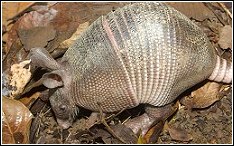
To Avoid The Damage They Do
The Problem With Armadillos
Armadillos particularly like soft rich soil like that provided by flower beds and beautiful manicured lawns because those environments are rich in the grubs they love. Armadillos are sometimes blamed for eating farm crops when in actuality it is not the crops they are after but the grubs, worms, ants, beetles and other insects that inhabit the rich soil the crops are grown in. Armadillos can also dig burrows under your trees, shed, driveway, home, crawl space, porch or foundation. They can create multiple burrows, sometimes connecting at a central point; these burrows can be as large as 4-12' long each.
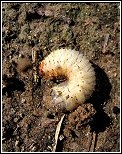
Food Of Armadillos
Signs Of Armadillos Around The House
Burrows under trees and buildings, conical holes in your lawn, and destroyed flower beds are often an indicator that you might have an armadillo problem around your house. Feces like that shown in the photo below can also be an indicator of a potential armadillo issue.
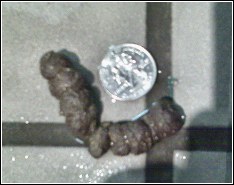
Humane Natural Armadillo Removal And Prevention
One of the best ways to prevent Armadillo damage is to prevent them from coming around in the first place. Fencing can actually be quite helpful in the battle against nuisance armadillo wildlife, but for it to be effective it will need to go a foot or more into the ground. If armadillos are creating burrows or digging under your crawl space, shed or foundation, use our very own patent protected innovation - Dig Defence® Animal Control.

Keep Armadillos Out
Dig Defence® will stop these bulldozers dead in their digging tracks. If they are digging under a fence to enter your yard, this product will also exclude them forever. Dig Defence® products can also help ward off skunks and other burrowing nuisance wildlife critters.
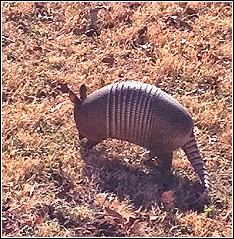
Within the past five years, the use of black colored mulch and rubber mulch in flower beds, similar to that seen below, has become popular with many homeowners. The Wildlife Whisperer, Inc. offices have surveyed each caller who complained about armadillos causing damage in their flower beds and had interesting results. Most homes that have rubber or black mulch had increased armadillo damage whereas homes with no mulch or other types of mulch had less severe damage.
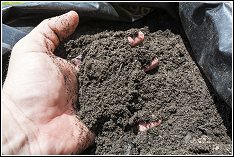
That Armadillos Like To Eat
Black and rubber mulch appear to heat the soil more, making it more appealing to grubs and worms, therefore making it more attractive to armadillos and other "grubbing" animals, such as skunks.
Armadillos are typically non-aggressive and tend to run away when threatened, however, their claws can be harmful and any handling of the animals should be left to a professional such as your local Wildlife Whisperer, Inc. Contrary to popular belief most species of armadillo cannot roll up into a ball to protect themselves, including the Nine-banded variety found in the United States.
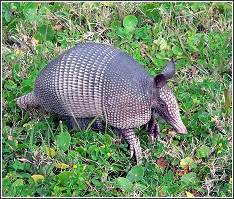
What Parks Have To Offer
If you are trying to view any potential armadillos around your home, remember that armadillos are nocturnal, and are most active around dawn and dusk.
Armadillo Facts & Information
The armadillo is a nocturnal mammal known for its protective shell which covers its body like a coat of armor. The armadillo is neither a rodent nor a marsupial, but is actually related to the anteater and sloth. Armadillos are native to the Americas and come in a variety of species from the tiny pink fairy armadillo to the nine-banded species found in the U.S.
Armadillo Range And Habitat
Armadillo wildlife is most common in the central southern, far south and southeastern areas of the country, particularly Texas. They have slowly spread northward and westward. However, their expansion is limited because their anatomy does not have the required insulating fat reserves that would allow them to do well in extreme cold temperatures.
The warm Florida climate is perfect for armadillos and they are prolific in Southwest Florida, consequently, finding expert armadillo control, prevention, and removal is very important in Cape Coral, Pine Island, Boca Grande and surrounding areas.
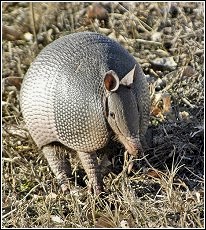
Problem For Florida Residents
Armadillo Habits & Behavior
For the most part, Armadillos are non-aggressive and tend to run away when threatened, however, their claws can be harmful and any handling of the animals should be left to a professional such as your local Wildlife Whisperer. Contrary to popular belief most species of armadillo cannot roll up into a ball to protect themselves, including the Nine-banded variety found in the United States. If you are trying to view any potential armadillos around your home, remember that armadillos are nocturnal, and are most active around dawn and dusk.
The armadillo has surprising physical abilities. Armadillos tend to be able to move quickly in spite of their short legs and the Nine-banded armadillo has a tendency to jump straight in the air when startled - up to 2 feet in the air at times. This habit helps startle predators but gets them into trouble when passing under cars on the highway, making them a common road kill fixture on many Florida roads.
Armadillos and opossum both eat road kill carrion at night when passing vehicles can accidentally hit them. Because of this, in many areas, the opossum is the most common road killed animal and armadillos are the 2nd most common.

Fun Facts About Armadillos
An uncanny ability that the armadillo has is their ability to swim in spite of their heavy shells and unusual anatomy - they swim by inflating their stomachs and intestines with air for floatation and can even remain underwater for as long as six minutes. They can also walk along the bottom of ponds and streams and their strong legs and claws enable them to have an effective ability to "dog paddle" as needed. In general, they love the water and it helps keep them cool during warmer months.
Armadillos tend to release a musky smell, an odor that intensifies when threatened. They also make noises from time to time including grunting noises as they search for food and squeaks and squeals when they feel threatened. They have long sticky tongues that enable them to slurp up fast moving ants and other insects as needed. Armadillos have poor eyesight but a keen sense of smell.
The armadillo is also famous for the fact their litters are always formed from the same egg, making each offspring in the litter genetically identical to each other. This phenomena known as "polyembryony" makes armadillo litters particularly valuable for medical research studies.
In spite of how interesting the Armadillo is, you do not want them damaging your lawn and flower beds. If you have an armadillo problem call your local humane wildlife control professional today.

1242 SW Pine Island Rd., Suite 310
Cape Coral, Florida 33991-2126
help@totalwildlifecontrol.com














